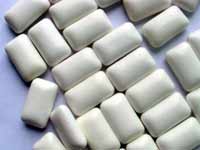Too much chewing gum may kill you
A 21-year-old woman came to consult a doctor about her clearly pathological thinness. She also suffered from stomachaches and severe diarrhea. These are common symptoms of serious diseases, maybe even cancer. The woman was thoroughly examined by ultrasound, computer tomography, gastroscopy and colonoscopy (much like gastroscopy, but a CCD camera or a fiber optic camera on a flexible tube is passed through the anus). Doctors found nothing. The diagnosis was made when it turned out that the woman chewed three or four packs of sugar-free gum a day. That means she consumed 18-20 grams of sorbite (each piece contains 1.25 gram), a sugar substitute with a purgative effect. Moreover, gum contains other purgative sweeteners (xylitol, maltitol and mannitol). If it sounds unbelievable, you can have a look at your pack of sugarless gum. You will not find there a warning how gum can damage your health.

From their experience with diabetics doctors know that 30-40 grams of sugar substitute will surely cause diarrhea. For some people five or ten grams will be enough. Experts are aware of the so-called ‘case of stewardess’ published in medical journal Lancet. The woman suffered from diarrhea and stomachaches for seven years, and doctors could not find the cause of the disease. She was thoroughly examined as well. The reason of her illness came out incidentally, when it became known that she consumed about 60 pieces of sugar-free chewing gum a day.
New facts about chewing gum have been made public by scientists from the University of Berlin. They observed two people who used chewing gum to lose weight. They lost 20 percent of their weight in a year. These are good results, but we warn you off using this method, as it poses a great hazard to health. Sorbite withdraws water and salts, not fat. These losses can damage your health. So if you feel some discomfort in your stomach after chewing gum, or if you have trouble with wind or spasms, then find another way to save your teeth from caries.
But gum does not only purge, but reinforces your intestines. Several years ago the US Pediatrics Journal described cases of children’s poisoning caused with chewing gum. A boy and a girl, 4 years old each, suffered from incurable constipation. In their rectums they had large conglomerates that could be removed only under anaesthetic. They turned out to be stuck with chewing gum. Another child mentioned in the article was only a year and a half.
The doctors who observed those children did not let them chew gum until they could come to realize that it was strictly forbidden to swallow gum. They recommend to place this warning on packaging for some slow-witted parents.
Numerous commercial ads assure us that gum tastes exactly like a water-melon, raspberries and other delicious gifts of nature. One should simply read the list of ingredients on a pack of chewing gum to find out absolutely the opposite. Gum may taste like sweet mint due to “natural identical and artificial flavorings.” Food chemicals may give strawberry and many other tastes to any chewing gum. Do not be misled with the words “natural identical.” Those substances are synthesized in chemical laboratories. It is well known that chemistry cannot reproduce biochemistry to the full.
By the way, gum has its colour thanks to chemistry as well. E171 dyestuff is most commonly used for the purpose. It is titanium dioxide, or titanium white, like house-painters say. It is extracted from the naturally occurring mineral Ilmenite, (named after the Ilmen Mountains in Russia), an iron-black, heavy, metallic oxide mineral, composed of iron and titanium oxide. Formerly this paint was authorized only for the production of cosmetics, soap and construction materials.
Arguments and Facts
Translated by Julia Bulygina
Pravda.ru
Subscribe to Pravda.Ru Telegram channel, Facebook, RSS!


